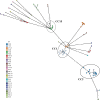In silico and in vitro comparative analysis of 79 Acinetobacter baumannii clinical isolates
- PMID: 40377313
- PMCID: PMC12210950
- DOI: 10.1128/spectrum.02849-24
In silico and in vitro comparative analysis of 79 Acinetobacter baumannii clinical isolates
Abstract
Acinetobacter baumannii is a significant nosocomial bacterial pathogen that poses a substantial infection risk due to its high resistance to antibiotics and ability to survive in hospital environments. In this study, we performed comprehensive in silico and in vitro analyses on 79 A. baumannii clinical isolates from different geographical locations to uncover their genomic and epidemiological characteristics as well as their antibiotic and phage susceptibilities. Our findings revealed considerable genomic diversity among the isolates, as shown by average nucleotide identity (ANI) heat maps, multilocus sequence typing (MLST), and core genome MLST (cgMLST). We identified several international clones known for their high antibiotic resistance and global prevalence. Surprisingly, we also observed that the number of antimicrobial resistance genes (ARGs) was higher in isolates containing CRISPR-Cas systems. Plaque assays with 13 phages indicated that Acinetobacter phages have a narrow host range, with capsule loci (KL) serving as a good indicator of phage-bacteria interactions. The presence of CRISPR-Cas systems and other antiviral defense mechanisms in A. baumannii genomes also appears to play a key role in providing phage resistance, regardless of the phage receptors. We also found that spacers associated with subtypes I-F1 and I-F2 CRISPR-Cas systems predominantly target prophages, suggesting a role in maintaining genomic stability and contributing to phage-bacteria co-evolution. Overall, this study provides a set of highly characterized A. baumannii clinical isolates for future studies on antibiotic-phage-bacteria interactions.IMPORTANCEAcinetobacter baumannii poses a significant challenge to the healthcare system due to its antibiotic resistance and strong survival mechanisms. This study examines a diverse collection of 79 clinical isolates to deepen our understanding of A. baumannii's genetic characteristics and its defense mechanisms against both antibiotics and phages. Genomic analysis revealed globally prevalent, highly resistant clones and uncovered a complex role for CRISPR-Cas systems. Although CRISPR-Cas systems were not widespread among these isolates, they primarily targeted prophages. Additionally, the study emphasizes the importance of capsule types as indicators of phage susceptibility. Together, these findings provide insights into the pathogen's resilience and evolutionary adaptations, potentially guiding future research on infection control strategies and new therapeutic approaches to combat A. baumannii infections.
Keywords: Acinetobacter baumannii; CRISPR-Cas; antimicrobial resistance (AMR); bacteriophages; capsule loci (KL); multilocus sequence typing (MLST); phages.
Conflict of interest statement
The authors declare no conflict of interest.
Figures





Similar articles
-
Isolation and characterization of phages ΦZC2 and ΦZC3 against carbapenem-resistant Acinetobacter baumannii, and efficacy of ΦZC3 on A549 cells.Virol J. 2025 Jul 30;22(1):262. doi: 10.1186/s12985-025-02885-6. Virol J. 2025. PMID: 40739242 Free PMC article.
-
Genotypic diversity and antimicrobial resistance phenotype of carbapenem-resistant and carbapenem-susceptible Acinetobacter species isolates.Pathology. 2025 Aug;57(5):637-642. doi: 10.1016/j.pathol.2024.12.647. Epub 2025 Mar 12. Pathology. 2025. PMID: 40204623
-
Susceptibility toward cefiderocol and sulbactam-durlobactam in extensively drug-resistant Acinetobacter baumannii detected from ICU admission screening in Hanoi, Vietnam, 2023.Microbiol Spectr. 2025 Jul;13(7):e0083225. doi: 10.1128/spectrum.00832-25. Epub 2025 Jun 9. Microbiol Spectr. 2025. PMID: 40488459 Free PMC article.
-
Molecular sequence typing of carbapenem-resistant Acinetobacter baumannii clinical isolates: A comprehensive global update.Infect Genet Evol. 2025 Jul;131:105762. doi: 10.1016/j.meegid.2025.105762. Epub 2025 May 10. Infect Genet Evol. 2025. PMID: 40349940 Review.
-
Prevalence of colistin resistance in clinical isolates of Acinetobacter baumannii: a systematic review and meta-analysis.Antimicrob Resist Infect Control. 2024 Feb 28;13(1):24. doi: 10.1186/s13756-024-01376-7. Antimicrob Resist Infect Control. 2024. PMID: 38419112 Free PMC article.
Cited by
-
Complete genome of five Acinetobacter baumannii phages.Microbiol Resour Announc. 2025 Aug 14;14(8):e0046325. doi: 10.1128/mra.00463-25. Epub 2025 Jul 11. Microbiol Resour Announc. 2025. PMID: 40643002 Free PMC article.
References
-
- Mohd Sazlly Lim S, Zainal Abidin A, Liew SM, Roberts JA, Sime FB. 2019. The global prevalence of multidrug-resistance among Acinetobacter baumannii causing hospital-acquired and ventilator-associated pneumonia and its associated mortality: a systematic review and meta-analysis. J Infect 79:593–600. doi: 10.1016/j.jinf.2019.09.012 - DOI - PubMed
-
- Tacconelli E, Carrara E, Savoldi A, Harbarth S, Mendelson M, Monnet DL, Pulcini C, Kahlmeter G, Kluytmans J, Carmeli Y, Ouellette M, Outterson K, Patel J, Cavaleri M, Cox EM, Houchens CR, Grayson ML, Hansen P, Singh N, Theuretzbacher U, Magrini N, WHO Pathogens Priority List Working Group . 2018. Discovery, research, and development of new antibiotics: the WHO priority list of antibiotic-resistant bacteria and tuberculosis. Lancet Infect Dis 18:318–327. doi: 10.1016/S1473-3099(17)30753-3 - DOI - PubMed
-
- Son H-J, Cho EB, Bae M, Lee SC, Sung H, Kim M-N, Jung J, Kim MJ, Kim S-H, Lee S-O, Choi S-H, Woo JH, Kim YS, Chong YP. 2020. Clinical and microbiological analysis of risk factors for mortality in patients with carbapenem-resistant Acinetobacter baumannii bacteremia. Open Forum Infect Dis 7:ofaa378. doi: 10.1093/ofid/ofaa378 - DOI - PMC - PubMed
Publication types
MeSH terms
Substances
Grants and funding
LinkOut - more resources
Full Text Sources
Miscellaneous

